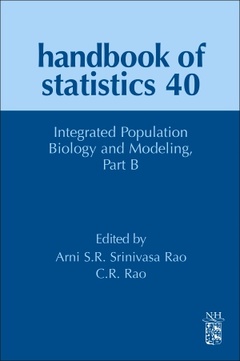Integrated Population Biology and Modeling Part B Handbook of Statistics Series

Integrated Population Biology and Modeling: Part B, Volume 40, offers very delicately complex and precise realities of quantifying modern and traditional methods of understanding populations and population dynamics, with this updated release focusing on Prey-predator animal models, Back projections, Evolutionary Biology computations, Population biology of collective behavior and bio patchiness, Collective behavior, Population biology through data science, Mathematical modeling of multi-species mutualism: new insights, remaining challenges and applications to ecology, Population Dynamics of Manipur, Stochastic Processes and Population Dynamics Models: The Mechanisms for Extinction, Persistence and Resonance, Theories of Stationary Populations and association with life lived and life left, and more.
Section VI: Agent Based Models, Capture-Recapture Methods and Multi-Species Mutualism 1. An Agent-Based Model of the Spatial Distribution and Density of the Santa Cruz Island Fox Shelby M. Scott, Casey E. Middleton and Erin N. Bodine 2. Capture–Recapture Methods and Models: Estimating Population Size Ruth King and Rachel McCrea 3. Mathematical Modeling of Multispecies Mutualism: From Particular Models Toward a Generalization of the Concept Paul Georgescu, Daniel Maxin, Laurentiu Sega and Hong Zhang
Section VII: Stochastic Complexity and Structural Dynamics 4. Stochastic Models for Structured Populations Shripad Tuljapurkar and David Steinsaltz 5. Studying Complexity and Risk Through Stochastic Population Dynamics: Persistence, Resonance, and Extinction in Ecosystems Anuj Mubayi, Christopher Kribs, Viswanathan Arunachalam and Carlos Castillo-Chavez 6. Analyzing Variety of Birth Intervals: A Stochastic Approach Ram Chandra Yadava and Piyush Kant Rai
Section VIII: GWAS, Species Divergence and Bayesian Item Response Theory 7. Detection of Quantitative Trait Loci From Genome-Wide Association Studies David A. Spade 8. Bayesian Item Response Theory for Cancer Biomarker Discovery K. Ramachandra Murthy, Salendra Singh, David Tuck and Vinay Varadan 9. Effects of Phenotypic Plasticity and Unpredictability of Selection Environment on Niche Separation and Species Divergence Narayan Behera
Section IX: Aging and Age-structured Population Dynamics 10. Backward Probabilities Estimated From Cross-Longitudinal Surveys and How Age-Specific Backward Prevalences Could Help Analyzing Trends in Aging Societies Nicolas Brouard 11. Behavior of Stationary Population Identity in Two-Dimensions: Age and Proportion of Population Truncated in Follow-up Arni S.R. Srinivasa Rao and James R. Carey 12. Demographic Situation of Manipur, India Moirangthem Hemanta Meitei
Section X: Collective Behaviors in Ecology 13. Deriving Mesoscopic Models of Collective Behavior for Finite Populations Jitesh Jhawar, Richard G. Morris and Vishwesha Guttal 14. Collective Behavior and Ecology Glenn R. Flierl
Graduate students to senior researchers in statistics and applied mathematicians who wish to refer to very rich and authentic collection in population models and their analytical solutions to their real-world applications. Research scientists and quantitative biologists would find it fascinatingly replicative information stored in this volume.
- Studies human and animal models that are studied both separately and throughout chapters
- Presents a comprehensive and timely update on integrated population biology
Date de parution : 02-2019
Ouvrage de 653 p.
15x22.8 cm
Thème d’Integrated Population Biology and Modeling Part B :
Mots-clés :
1PL; 2PL; 3PL; Abundance; Agent-based model; Agent-based models; Aggregation; Biomarker information function; Bounding thresholds; Captive cohort; Capture histories; Clinical trials; Closed birth interval; Coexistence equilibrium; Collective behavior; Collective decision-making; Collective motion; Cross-longitudinal survey; Demographic goals; Demographic noise; Demography; Derivatives of stochastic growth rate; Discrete covariates; Dynamical systems; Ecology; Ergodicity; Ethnicity; Evolutionary ecology; Evolutionary equilibrium; First birth interval; Fokker–Planck equation; Food width; Forward birth interval; Generalization; Genetic marker detection; Geographic information system data; Global stability; Golden eagle; Graded response; Heterogeneity; Interior birth interval; IRT; KeywordManipur; Labor force; Langevin equation; Life expectancy; Likelihood; Long-run growth rate; Lyapunov exponent; Markov chain; Migration distribution; Mixtures; Models; Mortality; Most recent closed birth interval; Multiplicative noise; Multistate; Mutualism; Niche separation; Noise-induced transitions; Nonlinear dynamics; NPP 2000; Numerical simulation; Open birth interval; Partial credit; Partition function; Phenotypic plasticity; Polymorphism; Population age structure; Population dynamics; Predator–prey dynamics; Random matrix product; Rasch; Rating scale; Sampling frame; Santa Cruz island fox; Single-nucleotide polymorphism; Small-noise approximation; SNP phasing; Spatial dynamics; Spatial effect; Statistical genomics; Statistical phylogenetics; Statistics; Stochastic algorithms; Stochastic population dynamics; Stochastic processes; Stochastic vital rates; Structured populations; Theoretical ecology; Truncation effect; WAIC
